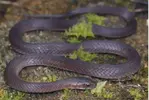Elusive mountain creature — with ‘metallic purple’ body — discovered as new species
A“metallic purple” mountain creature slithered along a dry stream on the tallest peak in Vietnam. Perhaps its shiny body gave it away, or maybe its coloring was just too noticeable. Nearby scientists spotted the animal — and discovered a new species.
Researchers ventured into the high-altitude forests of Mount Fansipan to study threatened species, co-authors Daniel Kane and Luan Thanh Nguyen wrote in a Sept. 6 news release from the Zoological Society of London.
Although they were looking for frogs, the researchers found something else entirely.
“Returning to camp shortly after midday after collecting supplies, two porters from the local H’mong community — Chang A. Sung and Pao A. Vang — came across a small, metallic purple snake,” the release said.
The snake was slithering “along a dry streambed” when it was captured, according to a study published Sept. 7 in the journal Zootaxa.
Researchers looked at the snake and realized it “didn’t match the description” of any known species, the release said. In a genetic database, they found an unidentified snake from China that was a “near-identical match” to the snake found on Mount Fansipan.
Researchers soon realized they’d discovered a new species of snake: rhabdophis hmongorum, or the H’mong keelback, the study said.
The H’mong keelback snake measures about 20 inches in length, researchers said. Its scales are smooth near its head and become increasingly rougher in texture toward its tail. The snake’s body is “purplish gray with distinct iridescence.” Its stomach is also “iridescent.”
Photos show the belly of a H’mong keelback snake. It has a brown color and is very shiny. The shine makes it look like there are small rainbows along its body.
Despite several more expeditions to look for H’mong keelback snakes, researchers couldn’t find any more of these elusive reptiles. So far, the new species has only been found on Mount Fansipan, but it probably lives in China as well, the study said.
Mount Fansipan is about 160 miles northwest of Hanoi and near the Vietnam-China border. It’s the tallest mountain in Vietnam, the release said.
Researchers named the new species for the H’mong people, “an ethnic minority people in the northwest montane regions of Vietnam,” the study said.
“Throughout the years we’ve worked in the region, the contribution of porters from the local H’mong community — such as Chang A. Sung and Pao A. Vang — has been invaluable to the success of these expeditions,” Kane and Nguyen said in the release.
The new species was identified based on its scale pattern, coloring, location, genitalia and teeth, the study said. DNA analysis found the new species “is as much as 4% different from its next closest relative,” the news release said.
Keelback snakes are “generally medium-sized, semi-aquatic snakes found across south, east, and southeast Asia,” Kane and Nguyen said in the release. Although often venomous, these snakes are “generally harmless to humans.”
Researchers said in the study that additional surveys are needed to determine the H’mong keelback snake’s geographic distribution, population size and behavior.
The research team included Daniel Kane, Benjamin Tapley, Toi Van La and Luan Thanh Nguyen. The research was also a collaboration among the Zoological Society of London, the Asian Turtle Program of Indo-Myanmar Conservation and Hoàng Liên National Park.



